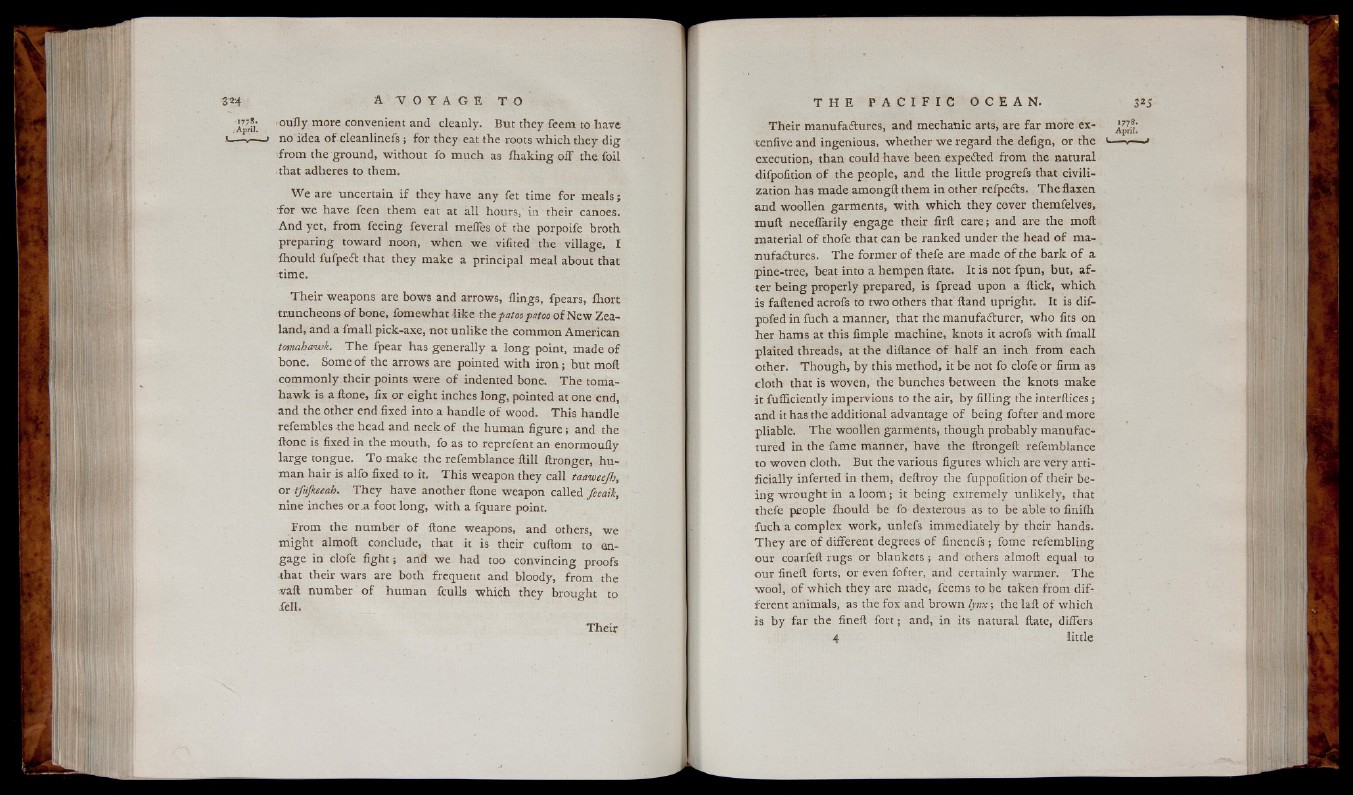
ou'fly more convenient and cleanly. But they feem to have
no idea o f eleanlinefs ; fo r they eat the roots w h ich they d ig
from the ground, without fo much as fh a k in g o ff the foil
that adheres to them.
We are uncertain i f they have any fet time fo r meals ;
fo r w e have feen them eat at a ll hours, in their canoes.
And yet, from fee ing feveral meffes o f the porpoife broth
preparing toward noon, when we vifited the village, I
ihould fu fp e it that they make a principal meal about that
time.
T h e ir weapons are bows and arrows, flings, fpears, fliort
truncheons o f bone, fomewhat lik e thepatoopatoo o f New Zealand,
and a fmall pick-axe, not unlike the common American
tomahawk. T h e fpear has gen erally a lo n g point, made o f
bone. Some o f the arrows are pointed w ith ir o n ; but moil
commonly their points were o f indented bone. T h e tomah
aw k is a flone, fix or e ight inches long, pointed at one end,
and the other end fixed into a handle o f wood. This handle
refembles th e head and n eck o f the human figure ; and the
flone is fixed in the mouth, fo as to reprefent an enormoufly
la rge tongue. T o make the refemblance ftill ftronger, h u man
hair is alfo fixed to it. T h is weapon they call taaweejh,
or tftijkeeah. T h e y have another flone weapon called feeaik,
nine inches or sl foot long, with a fquare point.
From the number o f flone weapons, and others, we
m igh t almoft conclude, that it is their cuftom to eng
a g e in clofe fight ; and we had too convincing proofs
th a t their wars are both frequent and bloody, from the
waft number o f human fculls w hich they brought to
Tell.
-1778.
.April.
Their
T h e ir manufactures, and mechanic arts, are fa r more ex- ¿V®;
tenfive and ingenious, whether w e regard the defign, or the v., —y— >
execution, than could have been expected from the natural
difpofition o f the people, and the little progrefs that c iv ilization
has made amongft them in other refpects. T h e flaxen
and woollen garments, w ith w h ich the y cover themfelves,
muft neceffarily eng ag e their firft c a re ; and are the moft
material o f thofe that can be.ranked under the head o f manufactures,
T he former o f thefe are made o f the bark o f a
pine-tree, beat into a hempen ftate. It is not fpun, but, a fter
b e in g properly prepared, is fpread upon a flick, w hich
is fattened acrofs to two others that ftand upright. It is dif-
pofed in fuch a manner, that the manufacturer, w ho fits on
he r hams at this fimple machine, knots it acrofs w ith fmall
plaited threads, at the diftance o f h a lf an in ch from each
other. T h o u gh , b y this method, it be not fo clofe or firm as
cloth that is woven, the bunches between the knots make
it fufficiently impervious to the air, by filling the interftices;
and it has the additional advantage o f being fofter and more
pliable. T h e woollen garments, though probably manufactured
in the fame manner, have the ftrongeft refemblance
to woven cloth. But the various figures w hich are very artificially
inferted in them, deftroy the fup pofitionof their bein
g w rou ght in a lo om ; it b eing extremely u n like ly, that
thefe people ihould be fo dexterous as to be able to finiih
fuch a complex w ork, unlefs immediately by their hands.
T h e y are o f different degrees o f finenefs ; fome refembling
our coarfeft ru gs or blankets ; and others almoft equal to
our fineft forts, or even fofter, and certainly warmer. The
wool, o f w hich they are made, feems to be taken from different
animals, as the fox and brown lynx-, the laft o f which
is b y fa r the fineft fo r t ; and, in its natural ftate, differs
4 little